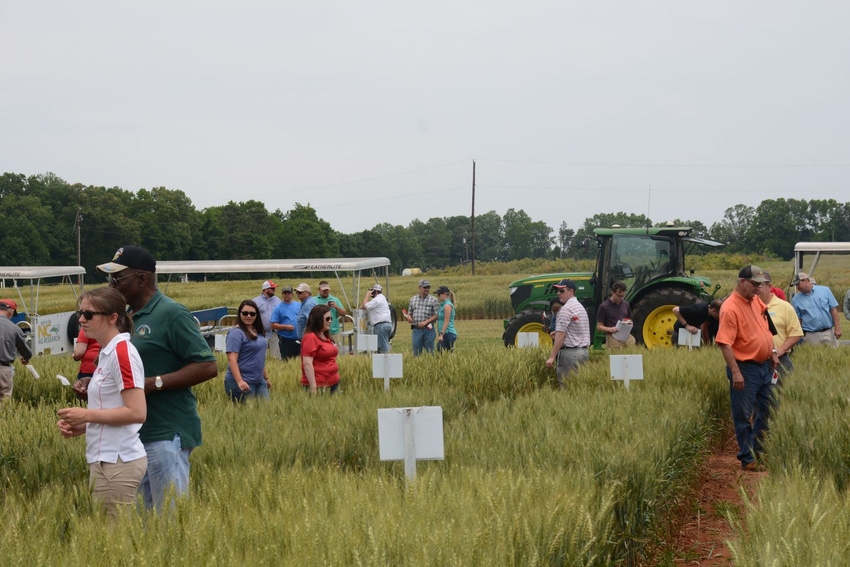
North Carolina Piedmont wheat crop recovers, yields still way down
The wheat crop in North Carolina’s Central Piedmont has generally recovered from the hard freeze of March 15 and 16, but yields will still be down significantly while the crop in the Southern Piedmont will still show devastating losses.

The wheat crop in North Carolina’s Central Piedmont has generally recovered from the hard freeze of March 15 and 16, but yields will still be down significantly while the crop in the Southern Piedmont will still show devastating losses.
That’s the word from Angela Post, North Carolina State University Extension small grain specialist, who adds that the crop in the rest of the state is looking good with wheat that wasn’t damaged by the freeze should make an average yield of 65 bushels per acre.
“We had projections of really heavy losses in the Central Piedmont,” Post said. “Those have actually recovered pretty nicely. An 80 to 90 percent loss was projected after the freeze, but we had a lot of recovery. However, those are spring tillers rather than fall tillers and they are still going to make a third of the grain that a fall tiller would make. Even though we had quite a bit of recovery, its’ still not going to be the yield potential we had before the freeze.”
Post still expects yields of 60 bushels per acre at the Piedmont Research Station site in Rowan County, but the crop in the Southern Piedmont, along the North Carolina/South Carolina border, is expected to show 80 to 90 percent losses.
Still, the rest of North Carolina should still see a good wheat crop this year.
“Anything that was planted on time and east of the 95 corridor, pretty much survived without a lot of damage. We should see 65 bushel averages in the eastern part of the state with some fields reaching 80 bushels. It certainly won’t be contest wheat like we’ve seen in the past, but there will be some happy farmers,” she said.
In the meantime, at Central Piedmont Small Grains Field Day at the Piedmont Research Station in Salisbury May 11, N.C. State wheat breeder Paul Murphy discussed the importance of vernalization and photoperiod in developing varieties that can tolerate spring freezes.
Murphy says the genes that control vernalization and photoperiod can be selected in the lab before varieties are brought to the field and this could be valuable for breeders. He is conducting research with two USDA molecular biologists in Raleigh vernalization and photoperiod.
Vernalization and photoperiod cause the transition of wheat at growth stage 30 when the plant goes from the grassy vegetative stage to the stem elongation, head development and grain development stage of reproductive growth.
Vernalization is the extended period of cold temperatures that wheat is exposed to. In wheat, vernalization occurs from 32 degrees to 46 degrees Fahrenheit. Photoperiod is the number of hours in a 24 hour period that the wheat is exposed to light.
“Photoperiod becomes more important in varieties that have short vernalization,” Murphy explained, adding that photoperiod may become more important in developing varieties that can tolerate spring freezes.
“Obviously it seems that vernalization is doing the heavy lifting, but vernalization depends on temperature and climate. Climate is pretty uncertain; seems like every spring we’re worried about late spring freeze,” Murphy said. “Maybe more emphasis should be placed on photoperiod. Day length depends on the angle of the earth as it rotates around the sun. That’s going to be pretty predictable for the next 1,000 to 2,000 years.”
Climate is far less predictable which is why photoperiod may be more important in wheat varietal development. “In other words, can we develop wheat varieties where it doesn’t matter what the temperature is, they will still head out between April 15 and April 30. There would be a lot less stress to the wheat community if we knew that was going to happen,” Murphy said.
As of now, the photoperiod genes in the germplasm of North Carolina wheat are not that robust. Murphy says they are “wishy washy” and don’t delay heading a huge amount. “Maybe it’s time for us to look at different photoperiod wheats from around the world that head out between April 15 and April 30. We can take those photoperiod genes and put them into our wheat,” he said.
Through it all, Post says wheat farmers across the state learned a lot from this year’s spring freeze and are looking forward to growing the crop again next year. She emphasized that wheat is still an important crop for North Carolina that is good for rotations and good for the land.
“Disappointed growers will move on and get corn and soybeans in the ground to replace their lost wheat crop,” Post said. “Still, some farmers will be happy that No. 1, they are going to make a crop, and No. 2, they are getting a better price than they expected at the beginning of the season. It’s too some extent to the detriment of those in the West, particularly in Kansas.it We hurt for them, the same they would hurt for us, but it did help the price for sure.”
About the Author(s)
You May Also Like





